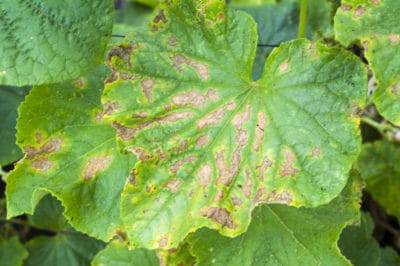The Blights and Their Symptoms
As fungal diseases, cucumber blights can spread into the garden on wind currents and throughout it by splashing water. Most active during warm, rainy weather, they survive for long periods in infected plant debris. The blights most commonly affecting cucumbers include:
Alternaria Leaf Spot
Alternaria attacks from the soil up. It surfaces with tiny brown leaf spots, often ringed in yellow. As the infection spreads, the leaves become completely brown before withering and dying.
Gummy Stem Blight
Gummy stem blight infects cukes at all stages. It affects an entire vine except the roots. On young seedlings, it surfaces with brown leaf spots. Older vines have yellowing leaf margins followed by brown leaf spots and fruit with mushy, sunken areas that ooze sticky black fluid when pressed.
Phytophthora Blight
Phytophthora also devastates cucumbers in all stages. Vines experience sudden, permanent wilting from their bases to their tips although their foliage stays green. As the infection worsens, they become brown and mushy at the soil line, with expanding, yellow or brown spots. Water-soaked areas covered in stringy white mold cover the fruit.
Expert gardener’s tip:These diseases also threaten other members of the cucumber family, including:
- Squash
- Watermelon
- Cantaloupe and other melons
- Pumpkin
Organic Cucumber Blight Control
When you’re battling cucumber blight, prevention is always preferable to control.
Cultural Measures
To keep blight out of the cuke patch, regularly remove plant debris and cover the soil with 2 inches of organic compost. It will stop blight spores from splashing onto the vines. Use drip irrigation or a soaker hose to prevent splashing. Trellis your cukes and prune excessive foliage periodically for better in air circulation.
Expert gardener’s tip: To avoid spreading disease, disinfect your pruning tools between cuts and after use in a solution of 1 part household bleach to 4 parts water.
Chemical Prevention
Spray your cukes with organic liquid copper two weeks before blight usually strikes in your area or whenever you’re expecting extended rain. If you see symptoms, spray immediately and repeat every week to 10 days until the symptoms and wet conditions subside. Always follow the label’s instructions regarding dosage and spraying frequency.
